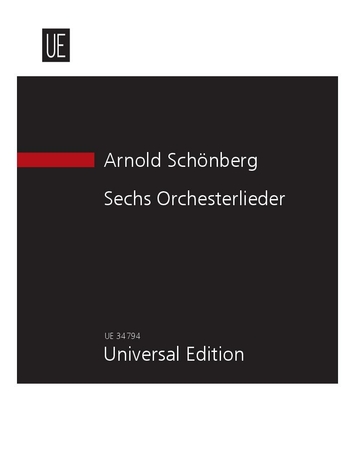.png)
Payments:
Shipping:
Arnold Schönberg
Schönberg: 6 Orchesterlieder for voice and orchestra - op. 8, for voice and orchestra
UE34794
Type: Studienpartitur
Series: Neue Studienpartituren-Reihe
Languages: Deutsch
Format: 170 x 240 mm
ISBN: 9783702467517
Pages: 152
ISMN: 979-0-008-08111-8
Payments:
Shipping:
Description
In the late summer of 1903, Arnold Schoenberg returned to Vienna with his wife and daughter after a one-and-half year stay in Berlin which, while lucrative from the compositional point of view, was largely unsuccessful professionally. His contract as musical director of the literary ‘Oberbrettl’ cabaret at Ernst von Wolzogen’s ‘Buntes Theater’ in Berlin which, despite its initial popularity with the Berlin high society, was a commercial flop, ran out after just one season. The teaching post at the ‘Stern’sches Konservatorium’ he had obtained through the intervention of Richard Strauss was limited to one semester. Through the mediation of his brother-in-law Alexander Zemlinsky (until 1906 artistic director of the Carltheater), Schoenberg’s professional situation in Vienna took a turn for the better, although his practical work – instrumentation and arrangements for the piano for two or four hands (among them Rossini’s The Barber of Seville, Lortzing’s Waffenschmied and Schubert’s Rosamunde for Universal Edition) – left him little time for composing.
After the piano songs op. 3, which were begun in Berlin and completed in Vienna, and an unfinished choral song with orchestral accompaniment (Darthulas Grabgesang), in the autumn of 1903 Schoenberg turned to what was for him – with the exception of the fragment Gethsemane for male soloist and orchestra from 1899, which has remained as a short score – a new genre: the orchestral song. As in opus 3, he used Des Knaben Wunderhorn as a text source and at the end of November 1903 started work on the manuscript for Das Wappenschild which he completed in April 1904. This was followed by the song Natur, based on a text by Heinrich Hart (written between 18 December 1903 and 7 March 1904, this composition also exists in an unfinished piano version), and the setting to music of one of Petrarch’s poems which appeared under the title Nie ward ich, Herrin, mud’ (the first manuscript is dated June 1904).
Schoenberg spent the summer of 1904 in Mödling at the home of the parents of his boyhood friend David Josef Bach. Here he worked, among other things, on his orchestral songs op. 8. On 3 July, Schoenberg completed the final score of Nie ward ich, Herrin, mud’. The composition referred to in a letter of 14 July addressed to Oskar Posa, the chairman of the musicians’ association ‘Vereinigung schaffender Tonkunstler’, was in all probability – if the source chronology is anything to go by – the song Voll jener Süße, based on a text by Petrarch: ‘I have begun a new song for orchestra (the 4th). I think it will be very good! This time I have taken it upon myself to combine all the techniques of part writing with the art of instrumentation. I hope I shall succeed.’
In the winter semester of 1904/1905 Schoenberg taught at the ‘Schwarzwald’sche Schulanstalten’ in Wallnerstrasse in Vienna’s first district. In 1904, this former girls’ school had been enlarged into a co-educational school and by the addition of a further education course for the promotion of artistic talent. Alongside his teaching activities, Schoenberg worked on his string quintet in D major (handed down as a fragment), in November 1904 finished the composition Voll jener Süße he had begun in Mödling, and made progress on Wenn Vöglein klagen and Sehnsucht (completed on 6 April 1905).
In October 1913, a full ten years after the creation of the first orchestral song and almost simultaneously with the composition of the first song from opus 22 (the only other composition of this type in Schoenberg’s oeuvre), the ‘meticulously revised’ scores of opus 8 were published as a separate edition by Universal Edition. Two years previously, in March 1911, this same publishing house had already brought out the vocal score, the piano reduction having been written by Anton Webern. On 14 July 1913, prior to the scheduled premiere of three songs from opus 8 to be conducted by Alexander Zemlinsky in Prague, Schoenberg wrote to his brother-in-law: ‘If given the choice, I would be more inclined towards the four songs for tenor voice than to the other two (Natur and Sehnsucht). Wappenschild is certainly the most effective. But I think the Petrarch songs are the best.’ Zemlinsky bowed to his wishes and at the premiere on 29 January 1914 conducted Das Wappenschild and the Petrarch songs Voll jener Süße and Wenn Vöglein klagen, the vocal parts being sung by the tenor of heroic roles Hans Winkelmann (son of the first singer of ‘Parsifal’ in Bayreuth, Hermann Winkelmann). Schoenberg, who was present at the event and had reminded Zemlinsky beforehand that Winkelmann ‘should sing p and, above all, legato [...] and should not speak the text too sharply’, wrote to him a few days later from Leipzig: ‘As you know, my ideas about interpretation differed somewhat from yours. But the interpretation is that which is transient and variable in a musical work. It is one of the methods used to portray the sense and to arouse the spirit to new life.’
Therese Muxeneder, Vienna, November 1998 (translated by Susan Perkins)
Contents
Natur (Heinrich Hart)
Das Wappenschild (aus "Des Knaben Wunderhorn")
Sehnsucht (aus "Des Knaben Wunderhorn")
Nie ward ich, Herrin, müd' (Petrarca)
Voll jener Süße... (Petrarca)
Wenn Vöglein klagen (Petrarca)
More information
Type: Studienpartitur
Series: Neue Studienpartituren-Reihe
Languages: Deutsch
Format: 170 x 240 mm
ISBN: 9783702467517
Pages: 152
ISMN: 979-0-008-08111-8

